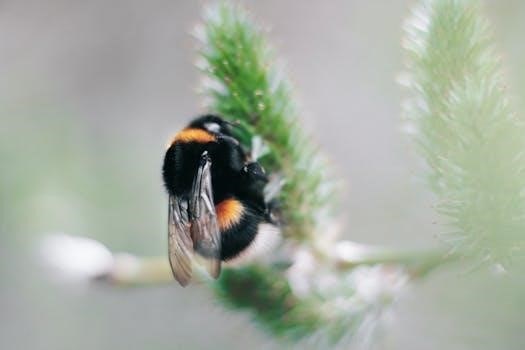Animal and Plant Cells Worksheet PDF⁚ An Overview
Explore the fascinating world of cells with our comprehensive animal and plant cells worksheet PDF! These worksheets offer a hands-on approach to learning about cell structures, functions, and differences, suitable for grades 4-8.

Identifying Cell Parts
Our worksheets feature detailed diagrams of both animal and plant cells, clearly labeling key organelles like the nucleus, mitochondria, and endoplasmic reticulum. Students can practice identifying these essential cell components through various engaging activities.
Labeling Animal Cell Diagrams
Enhance your students’ understanding of animal cell anatomy with our dedicated labeling activities. These worksheets provide clear and detailed diagrams of animal cells, prompting students to correctly identify and label various organelles. Tasks include labeling the nucleus, cytoplasm, ribosomes, and other vital structures.
These activities reinforce recognition skills and promote a deeper understanding of each organelle’s role within the cell. Students will also encounter terms like lysosomes and vacuoles, differentiating them by shape and function. This hands-on approach solidifies knowledge, making learning about animal cells both engaging and effective. Ideal for visual learners, these diagrams help students connect names with actual cell structures.
Labeling Plant Cell Diagrams
Our labeling plant cell diagrams worksheets provide an interactive way for students to learn about the unique structures found in plant cells. These diagrams showcase essential components such as the cell wall, chloroplasts, and large vacuoles. Students will identify and label these parts, distinguishing them from animal cell structures.
These activities reinforce understanding of plant cell anatomy and its role in plant function. By labeling diagrams, students connect visual representations with scientific terminology. Worksheets often include a key for easy checking, allowing for self-assessment and immediate feedback. Ideal for biology students, these diagrams promote a deeper understanding of plant cell structures.
Comparing Animal and Plant Cells
Delve into the similarities and differences between animal and plant cells. Our resources include Venn diagrams and charts, perfect for contrasting cell structures and functions in an engaging way.
Venn Diagram Activities
Enhance your students’ understanding of cell biology with our engaging Venn diagram activities. These activities are specifically designed to compare and contrast animal and plant cells, encouraging critical thinking and analytical skills. Students can visually organize the characteristics that are unique to each cell type, as well as the features they share, such as the presence of a nucleus, cytoplasm, and cell membrane.
Our Venn diagram worksheets provide a structured framework for students to identify and categorize cell components and their respective functions. This hands-on approach fosters a deeper comprehension of cell structures and promotes active learning in the classroom or at home.
Similarities and Differences Chart
The similarities and differences chart is an essential tool for students to systematically compare animal and plant cells. This chart provides a structured format for listing the characteristics of each cell type side-by-side, promoting a clear understanding of their distinct features and shared components. Students can easily identify the presence or absence of specific organelles, such as chloroplasts, cell walls, and vacuoles, in each cell type.
This visual aid enhances comprehension by organizing information in a concise and accessible manner. By completing the chart, students reinforce their knowledge of cell structures and improve their ability to differentiate between animal and plant cells.

Cell Organelle Functions
Delve into the intricate roles of cell organelles! Understand the specific functions of key components like the nucleus, endoplasmic reticulum, ribosomes, and mitochondria, vital for cell operation and overall biological processes.
Nucleus
The nucleus is the control center of the cell, housing the cell’s genetic material, DNA. It dictates cellular activities through gene expression. Within the nucleus lies the nucleolus, responsible for ribosome synthesis. This organelle regulates cell growth, metabolism, and reproduction. The nucleus ensures accurate DNA replication during cell division. Its membrane protects DNA from cytoplasmic enzymes, maintaining genomic integrity. The nucleus orchestrates protein synthesis, controlling the production of essential molecules. Damage to the nucleus can disrupt cellular function and lead to disease. It coordinates cell responses to external stimuli, adjusting gene expression accordingly. The nucleus plays a crucial role in heredity, passing genetic information to offspring, thereby ensuring the continuation of life.
Endoplasmic Reticulum
The endoplasmic reticulum (ER) is a network of membranes involved in protein and lipid synthesis. It exists in two forms⁚ rough ER and smooth ER. Rough ER is studded with ribosomes, aiding in protein production and modification. Smooth ER synthesizes lipids, phospholipids, and steroids, essential for cell structure and function. The ER transports molecules within the cell, ensuring efficient distribution. It also detoxifies harmful substances, protecting the cell from damage. Calcium storage is another vital function of the ER, regulating cellular signaling. The ER plays a role in protein folding, ensuring correct three-dimensional structure. Dysfunction of the ER can lead to various diseases, highlighting its importance. It connects to the Golgi apparatus, further processing and packaging proteins. The ER is a dynamic organelle, adapting to the cell’s changing needs, thus maintaining cellular homeostasis. It contributes to membrane biogenesis, creating new cellular membranes.
Ribosomes
Ribosomes are essential cellular components responsible for protein synthesis. Found in both plant and animal cells, these structures translate genetic code from mRNA into amino acid sequences, ultimately forming proteins. Ribosomes are composed of ribosomal RNA (rRNA) and proteins, existing as two subunits that combine during translation. They can be found freely floating in the cytoplasm or attached to the endoplasmic reticulum, forming rough ER. Free ribosomes produce proteins for use within the cell, while those on the ER synthesize proteins destined for secretion or insertion into membranes. The process of protein synthesis involves ribosomes binding to mRNA, reading the codons, and recruiting corresponding tRNA molecules carrying specific amino acids. Peptide bonds form between amino acids, creating a polypeptide chain. Ribosomes play a crucial role in all living organisms, ensuring proper cell function. Without ribosomes, cells cannot produce the proteins necessary for growth, repair, and various cellular processes. Their efficiency and accuracy are vital for maintaining cellular health and survival.
Mitochondria
Mitochondria, often dubbed the “powerhouses” of the cell, are vital organelles present in both animal and plant cells. These bean-shaped structures are responsible for generating most of the cell’s energy through cellular respiration. Mitochondria have a double membrane⁚ an outer membrane and a highly folded inner membrane called cristae. Cristae increase the surface area for chemical reactions, maximizing ATP production. ATP, or adenosine triphosphate, is the primary energy currency of the cell, fueling various cellular processes. During cellular respiration, glucose and oxygen are converted into carbon dioxide, water, and ATP. Mitochondria contain their own DNA and ribosomes, suggesting they were once independent prokaryotic organisms that entered into a symbiotic relationship with eukaryotic cells. The number of mitochondria varies depending on the cell’s energy requirements; cells with high energy demands, such as muscle cells, contain more mitochondria. Understanding the structure and function of mitochondria is crucial for comprehending cellular metabolism and energy production. Malfunctions in mitochondria can lead to various diseases, highlighting their importance in maintaining overall health.

Worksheet Activities
Enhance learning with engaging worksheet activities! Our PDF includes coloring organelles, matching descriptions to cell parts, and fill-in-the-blank exercises. These activities reinforce understanding of cell structures and functions.
Coloring Cell Organelles
Bring cell biology to life with our “Coloring Cell Organelles” activity! This engaging worksheet offers a hands-on way for students to learn about the different parts of animal and plant cells. By assigning specific colors to organelles like the nucleus, mitochondria, and endoplasmic reticulum, students visually reinforce their understanding of each component’s location and structure within the cell.
This activity enhances retention and makes learning fun and interactive. It also improves fine motor skills and artistic expression, making it a valuable addition to any cell biology lesson.
Perfect for visual learners and hands-on activities!
Matching Parts to Descriptions
Reinforce understanding of cell organelle functions with the “Matching Parts to Descriptions” exercise. This activity challenges students to pair each cell part with its corresponding function, solidifying their knowledge of organelles and their roles within animal and plant cells.
Students will connect terms like “nucleus” with its function as the cell’s control center or “mitochondria” with energy production. This exercise not only tests recall but also promotes a deeper comprehension of how each organelle contributes to the overall function of the cell.
Perfect for assessing understanding and reinforcing key concepts in cell biology.
Fill-in-the-Blank Exercises
Test your knowledge of cell structures with our “Fill-in-the-Blank Exercises.” These worksheets offer a dynamic way to reinforce learning about animal and plant cells. Students complete sentences by inserting the correct terms related to cell organelles and their functions.
This exercise encourages active recall and helps students solidify their understanding of key concepts. By identifying and filling in the missing words, learners enhance their comprehension of cell biology and improve their vocabulary.
Ideal for assessment or as a review exercise, these worksheets provide valuable practice in mastering the essential elements of cell structure and function.

Worksheet Applications
Our animal and plant cell worksheets are versatile tools for educators. Use them for classroom activities to enhance understanding or assign them as homework to reinforce learning outside the classroom.
Classroom Activities
Engage your students with dynamic classroom activities using our animal and plant cell worksheets. Begin with labeling exercises to identify cell parts, followed by a comparative Venn diagram activity to highlight similarities and differences. Coloring activities bring visual learning to life, while matching exercises solidify understanding of organelle functions. Facilitate group discussions to encourage collaborative learning and critical thinking about cell processes. These worksheets also provide a foundation for hands-on model building activities, allowing students to create 3D representations of plant and animal cells using diverse materials. Adapt the activities to suit different learning styles and promote a deeper understanding of cellular biology.
Homework Assignments
Reinforce classroom learning with targeted homework assignments using our animal and plant cell worksheets. Assign fill-in-the-blank exercises to review cell vocabulary and functions. Utilize comparison charts to encourage students to analyze and contrast cell structures. Provide diagrams for students to label and describe, promoting independent learning and critical thinking. Extend learning beyond the classroom by asking students to research specific organelles and their roles. Encourage creative expression by assigning students to design their own cell models or write short stories about life inside a cell. These homework assignments offer varied approaches to reinforce understanding and promote a deeper engagement with cellular biology concepts.
